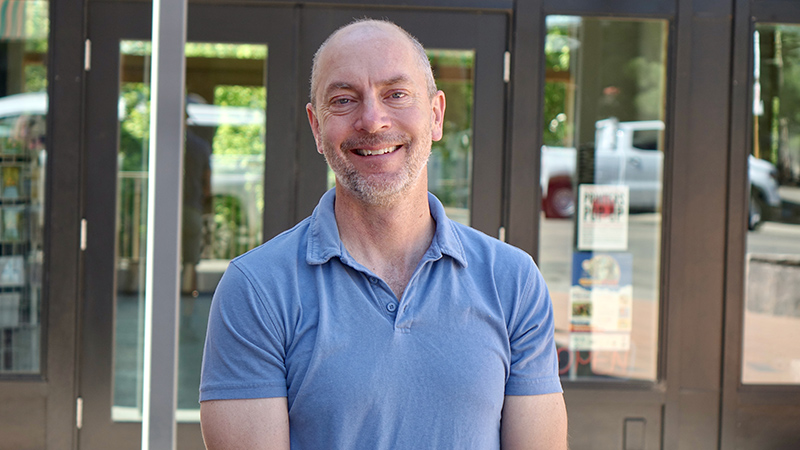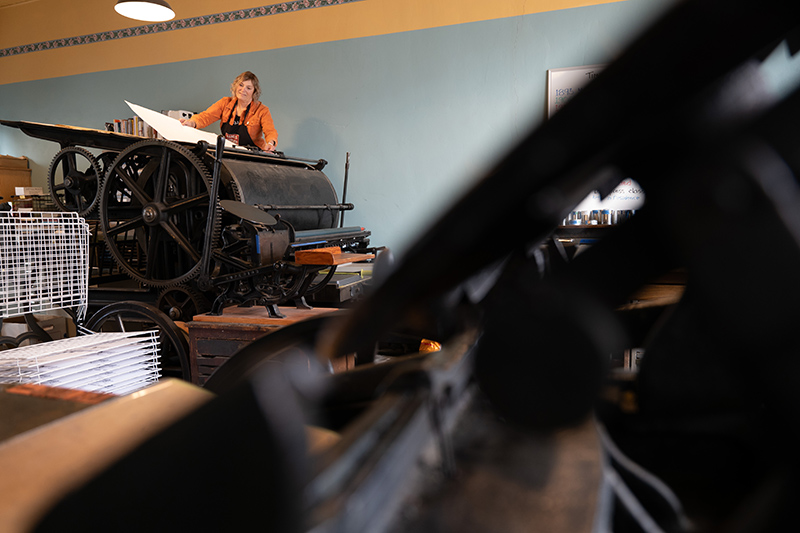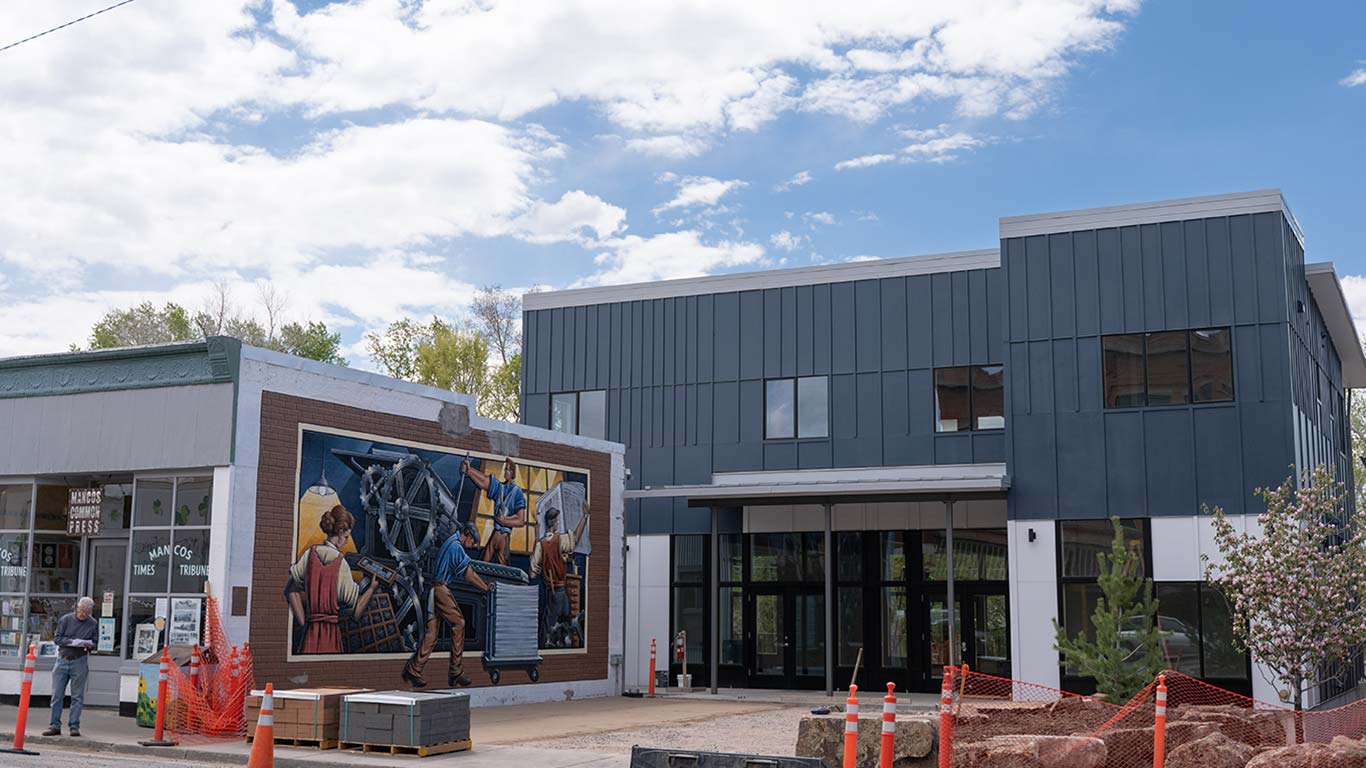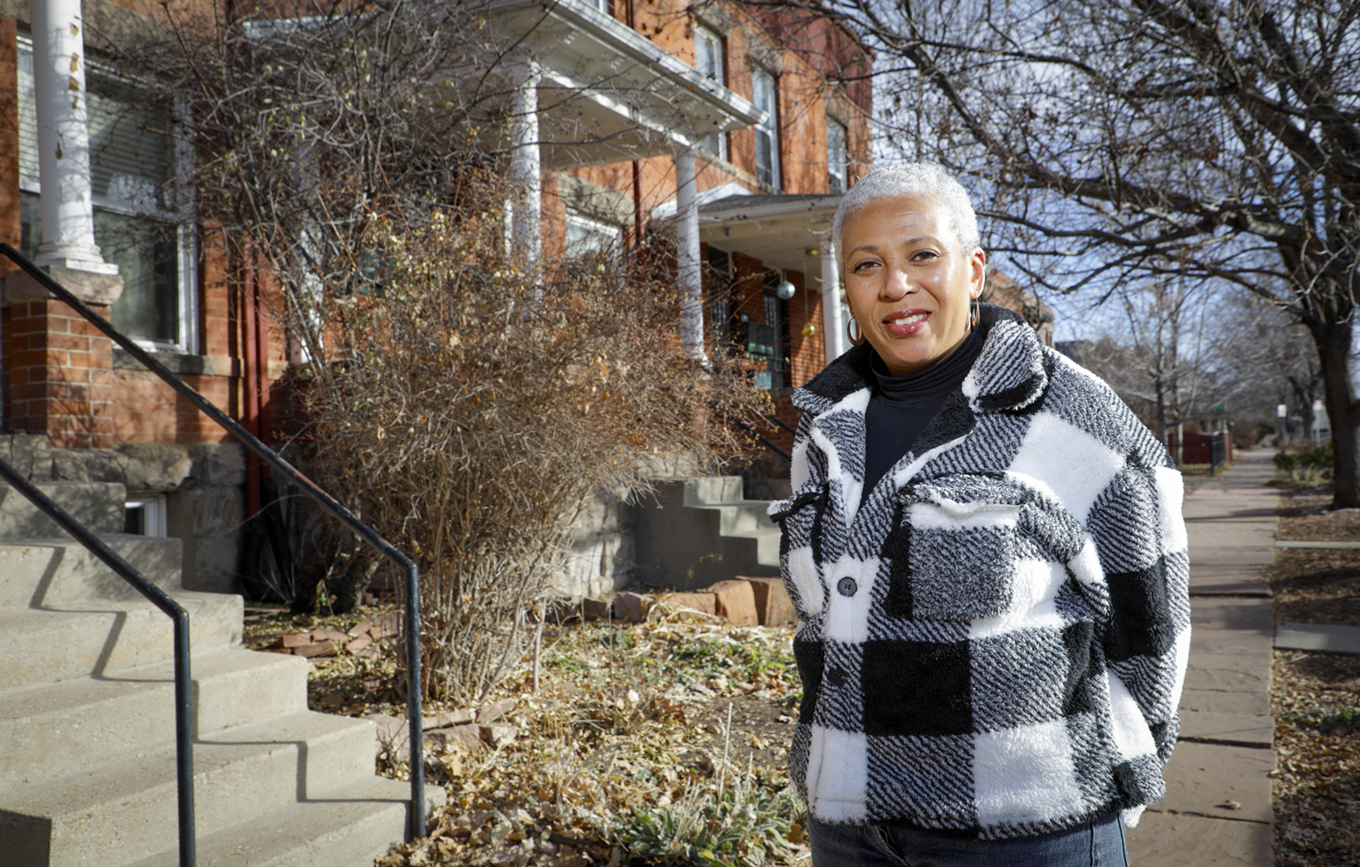A gleaming two-story glass and steel structure opened in mid-May in downtown Mancos, a town of 1,200 in southwest Colorado between Durango and Cortez.
The new building, known as Mancos Commons, is set back from Grand Avenue, the town’s main street. But it’s easy to spot in contrast to the century-old buildings all around.
The brick Mancos Opera House was built directly across the street when William Howard Taft was president in 1910. Two doors east sits the recently renovated Columbine Bar, also established in 1910 and one of the state’s oldest, longest-running watering holes.
Ironically, the new building was constructed to provide more space for a now-outdated technology—antique letterpresses—and today serves as a creative magnet for printmakers and artists who travel from around the region and country to produce art. But Mancos Commons brought more than just expanded capacity for creatives—it also includes new workforce housing units. Mancos leaders say the addition is a good start in providing affordable housing options for community members.
The project began nine years ago when the nonprofit that runs Mancos Press raised money to restore the original, long-shuttered building that housed the town’s newspaper office for nearly a century. The old storefront building houses a behemoth Cranston letterpress, which weighs 9,000 pounds and dominates the space inside.

Shop Manager Jody Chapel carries a tray of letters for typesetting through the Mancos Commons Press building on May 13, 2024. Photo by Corey Robinson / Special to The Colorado Trust
Tami Graham, one of the organization’s founding members, said demand from teachers and students for a graphic arts school built around the old newspaper letterpress and a smaller Chandler & Price platen press remains strong.
This year’s classes, all taught in the cramped existing Mancos Commons Press space, have included “Letterpress 101,” “DIY Guerilla Art Printing,” “Reduction Block Printing,” and “Herstory: Celebrating Women Through Printmaking.”
“It was pretty clear once we started doing programming that we were going to need more space—somehow,” Graham said.
The new space to expand Mancos Common Press and bring in even more types of printing wouldn’t have been built, however, without what’s on the second floor—three one-bedroom apartments available as “workforce housing” to qualified tenants.
“Three units may not seem like many in a lot of places, but in a small town, it could make a big difference,” said Margaret Hunt, former executive director of Colorado Creative Industries, which awarded the Mancos Commons project a $1.3 million grant. “Those apartments could house teachers at the local school or others who might not make the kind of wages that allow them to buy property.”

An empty one-bedroom apartment on the second floor of Mancos Commons, one of three workforce housing units built as part of the project. The room overlooks Grand Avenue in downtown Mancos. Photo by Corey Robinson / Special to The Colorado Trust
The three tenants are an ambulance driver, an employee of nearby Mesa Verde National Park and a newly hired math and science teacher at Mancos High School.
Richard Krueger, the high school teacher, moved in April from Flagstaff, Ariz., fulfilling a longtime dream of moving to Mancos.
“It didn’t seem like the stereotypical Colorado mountain town that got overrun by a ski area and transformed into Disneyland,” Krueger said.
During the COVID-19 pandemic, Krueger spent two weeks camping at a nearby campground.
“That’s when I first really spent some time here and I was like, ‘Wow, it would be great to live here,’” he said.
When he accepted the job at Mancos High School, Krueger thought he would have to lower his expectations for housing. The new job pays $4,000 less annually than his school salary in Flagstaff where he had started Flagstaff High School’s engineering program.
Out of the blue, said Krueger, “up pops this thing at Mancos Commons.” He had no idea that the snazzy new downtown building included housing when he first saw it going up, but he quickly applied.

Richard Krueger, a high school teacher in Mancos, was selected as one of the tenants to live in the workforce housing units of the Mancos Commons expansion. Photo by Mark Stevens / Special to The Colorado Trust
Mancos Mayor Cindy Simpson said she is thrilled by the project’s initial success.
“I think it’s a great start for getting more attainable housing in town,” said Simpson, who has worked off and on with the town planning and zoning commission and the town council for 20 years.
“It’s all percentages, right? We have a small town. Three units is a big whoop… I think the value in it is that people that grow up here maybe won’t have to move away.”
Funding for Mancos Commons was cobbled together with additional grants from the Colorado Division of Housing ($815,000), the Colorado Housing and Finance Authority (about $25,000 for predevelopment technical assistance), a wide variety of private foundations, and $100,000 from community members.
Ballantine Communications, which publishes The Durango Herald and The Cortez Journal, donated the original land and building to the Mancos Common Press and also gave the nonprofit the first right of refusal on purchasing the adjacent lot where the new structure was built. The University of Pennsylvania also played a key role in helping restore the machinery and reopening the original building, which became home to The Mancos Times-Tribune in 1910.

Jody Chapel, artist and shop manager at Mancos Commons, operates a historic printing press, on May 13, 2024. Photo by Corey Robinson / Special to The Colorado Trust
Why the University of Pennsylvania, 2,000 miles to the east? Frank Matero, chair of the university’s Department of Historic Preservation, started traveling to southwest Colorado in the early 1990s to work on a project at Mesa Verde National Park. On one stroll downtown in 2013, a curious Matero entered the old Mancos Times building and came upon the unused presses, a moment for preservationists that he compares to archaeologists finding Tutankhamun’s tomb. That day began the process of organizing a local nonprofit to restore the building and the abandoned presses inside and start attracting artists and printmakers.
According to the Colorado Department of Local Affairs, the grant from the Colorado Division of Housing for the Mancos Commons project was one of eight such grants statewide. The statewide pot of $31.2 million yielded 482 additional affordable housing units.
The state grant terms would have allowed tenants who earned up to 140% of the area median income (AMI) to qualify for housing, but the Mancos Common Press board opted for a lower maximum of 120%. As a result, tenants may not earn more than a maximum salary of $73,080 for single occupancy (or $83,520 for double occupancy). The minimum salary for a tenant is $50,700.
The initial search for qualifying tenants started within the Mancos ZIP code and was expanded to all of Montezuma County when not enough applications were turned in. Two units were rented before construction was complete; the third was filled by Krueger a week later.
Krueger said he barely squeaked into the project’s salary parameters—on the low end.
“The sad part is a 20-year veteran, masters-degree-holding teacher” barely qualified, he said.
The monthly rent for each of the 575-square-foot units is $1,100. By comparison, the online real estate company Zillow reports that the median rent for all property types in Mancos is $2,100 as of the middle of June. Existing one-bedroom rentals start at $1,800, with only three available rental vacancies.
Yet, in a town where the starting teacher pay is $40,000, the salary targets for the project looked high to some. “Affordable housing,” according to the Colorado Housing and Finance Authority, costs no more than 30% of gross household income for a given income level. In comparison, “workforce housing” refers to affordable housing for local workers earning a typical wage ranging from 50% to 120% of AMI.
These calculations aside, Simpson feels Mancos Commons is a step in the right direction.
“For the first major project—and I will say ‘major’ even though it’s only three units—Mancos Commons is leading the way,” she said. “I think this is a good indicator that people’s hearts are in the right place, and they’re putting their wallets in that same place. We were thrilled to be able to assist.”
The town government served as the pass-through agency on the grant. In a small town, Simpson said, the public-private partnership was required. The town has only 14 people on staff.
“There’s no way that we could act as a general contractor and then a leasing agent or anything like that,” Simpson said.
Colorado Creative Industries’ former director Hunt said she walked through the building last fall as it was being built, and “it just brought me to tears… it’s one thing to review a grant, but it’s another thing to see the work being done.”
“The passion and leadership are what make a difference in advancing the arts and creativity in a community,” Hunt added. “I’m always jealous when I see the postings on Facebook about the workshops that are happening now and the kind of work being produced. I wish other communities had that kind of iconic gathering place.”
The striking presence of a modern building settled among the century-old structures nearby, however, drew some criticism. One well-known local artist said the design has a “mausoleum” quality. Complaints about the dark color led to redoing selected areas in light gray before the tenants moved in.
Former Mancos Common Press board member Robin Strother said he thought the board could have done more to gather community input before construction, a point that board president Graham disputes with notes from the meetings.
But Strother predicted that the controversies surrounding the design process and the look of a striking, modern building in an old-West town would “fade into the past” over time. In the end, he said, the expanded space will allow larger groups of students and artists to work on the presses and enrich the artistic teaching and learning process.
“Small towns are constantly looking for identities, and at least I think we have partially found ours—assuming we can keep the momentum going,” he said. “We can’t be stuck in the past, and I want the younger generation in this town to stay here, live here and have an interest in the future of this town. In the end, I think Mancos Commons is going to be terrific.”
Krueger agreed, appreciative that he can walk mere minutes to the post office, grocery store or hop on his bike for a short ride to Family Dollar.
“It’s great. It’s top-notch,” Krueger said. “I feel like I won the lottery.”








